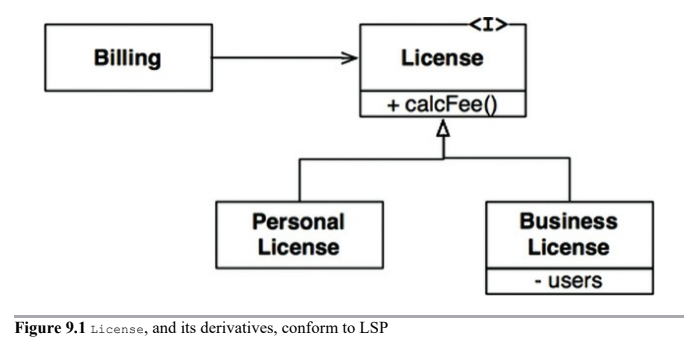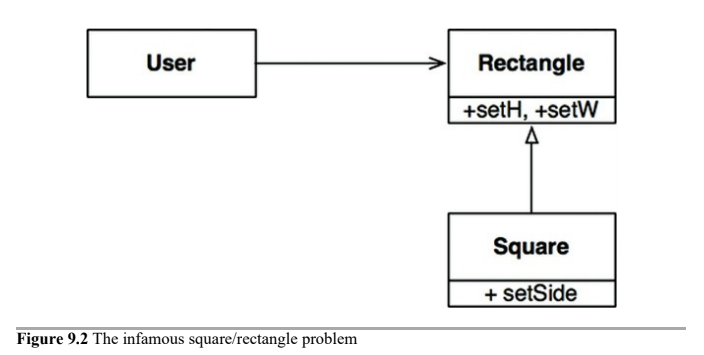Liskov Substitution Principle
- Definition
- Guiding the Use of Inheritance
- Square/Rectangle Problem
- LSP and Architecture
- LSP Architecture Violation
Definition
“If for each object
o_1of typeSthere is an objecto_2of typeTsuch that for all programsPdefined in terms ofT, the behavior ofPis unchanged wheno_1is sustituted foro_2thenSis a subtype ofT” - Barbara Liskov, 1988.
Guiding the Use of Inheritance
Suppose we have a class named License, that has a method named calcFee(), which is called by the Billing application. There are two “subtyes” of Licence that use different algorithms to calculate the license fee, PersonalLicense and BusinessLicense.

This design conforms to the LSP because the behavior of the Billing application does not depend, in any way, on which of the two subtypes it uses.
Square/Reactangle Problem
Canonical example of a violation of the LSP is the famed square/rectangle problem.

In this example, Square is not a proper subtype of Reactangle because the height and width of the Rectangle are independently mutable, where as the ones from Square must change together. Since the User believes it is communicating with a Rectangle, it could easily get confused.
For example, if the following code produced a Square then the assertion will fail:
Reactangle r = ...
r.setW(5)
r.setH(2)
assert(r.area() == 10); // Would fail if 'r' is a Square
The only way to defend against this kind of LSP violation is to add mechanisms to the User that detects whether the Rectangle is, in fact, a Square. Since the behavior of the User depends on the types it uses, those types are not substitutable.
LSP and Architecture
LSP has morphed into a broader principle of software design that pertains to interfaces and implementations. Users depend on well-defined interfaces, and on the substitutability of the implementations of those interfaces.
The LSP can, and should, be extended to the level of architecture. A simple violation of substitutability, can cause a system’s architecture to be polluted with a significant amount of extra mechanisms.
LSP Architecture Violation
Suppose we are building an aggregator for many taxi dispatch services, customers use our website to find the most appropriate taxi to use, regardless of taxi company. Our system dispatches the chosen taxi by using a restful service.
Now assume that the URI for the RESTful dispatch service is part of the information contained in the driver database.
Suppose Driver Bob has a dispatch URI that looks like this: purplecab.com/driver/Bob. Our system will append the dispatch information onto this URI and send it with a PUT, as follows:
purplecab.com/driver/Bob
/pickupAddress/24 Maple St.
/pickupTime/153
/destination/ORD
Clearly this means that all the dispatch services, for all the different companies, must conform to the same REST interface. They must treat the pickupAddress, pickupTime, and destination fields identically.
Now suppose the Acme taxi company didn’t read the spec very carefully and abbreviated the destination field to just dest. We would need to add a special case. The dispatch request for any Acme driver would have to be constructed using a different set of rules.
The simplest way to accomplish this goal would be to add an if statement before constructing the dispatch command…
if (driver.getDispatchUri().startsWith("acme.com")) ...
No architect would allow such a construction to exist in the system. Putting the world “acme” into the code itself creates an opportunity for all kinds of horrible and mysterious errors, not to mention security breaches.
For example, if Acme buys a new company “Purple” and unified all the original companies’ systems while keeping the separated brands and websites. Would we have to add another if statement?
We need then to add significant and complex mechanism to deal with the fact that the interfaces of the restful services are not all substitutable.